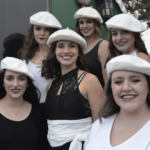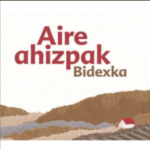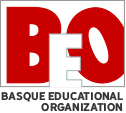2017 | Basque Mythology & Spirituality

KEYNOTE SPEAKER
Denise Orpustan-Love presented her book, The Mill House Speaks: Seven Pathways to the Ancestral Basque Homeland.
The Mill House Speaks is a remarkable story about the journey of returning to my father’s ancestral homeland in the Basque Country in the summer of 2015 with my children, following the passing of my beloved mentor, cultural anthropologist Angeles Arrien, Ph.D. In honoring the promise I made to her to do a project on Basque folklore, I honestly, candidly, and courageously share this journey. In this research trip to my father’s homeland in the Basque Country, I discovered that the “project” is much more than a collection of literature on ancient Basque folklore, but an ancestral journey of living folklore, tied to my father’s sacred mill house.
The Mill House Speaks integrates our daily synchronistic experiences on this summer research trip to the Basque Country in France. The Mill House Speaks describes in detail the life dreams of rebuilding Papa’s mill house and creating a project on Basque folklore with my mentor. Through daily observations, experiences, and storytelling in the village of my father, I reflect on the road that brought me here. Supported by literature on ancient Basque folklore and ethnographic research, I discover that all parts of the journey, the present and past, are united as one, just like the ancient etxe.
The seven pathways are the integrated aspects of this journey, reflecting the parts of the ancient Basque world and belief system. The seven pathways are a synthesis of this ancient Basque world, all connected to the major areas of life, including life lessons from nature and perennial wisdoms, daily life actions (sun), inner qualities/character attributes (moon), the cycles of the seasons, and everyday tools for building one’s life dream.
In its entirety, The Mill House Speaks is a guided journey of living folklore, both memoir and storytelling, for my children and future generations, to pass on the enduring wisdoms of the human spirit.

Mia Arostigui
PRESENTER
Mia Arostigui presented her research on the works which depict Basque mythological creatures, superstition, and characters from folklore purely based off of Basque artistic elements and writings.
“Being Basque means that very few people know what you are or where you come from. It involves pulling out maps, talking about the Pyrenees Mountains, re-pronouncing your last name, and emphasizing that you did not say “bass” like the fish. Pacific’s Summer Undergraduate Research Fellowship gave me the opportunity to learn more about my culture while using my discipline as a method to educate others about it. When I started this research journey, my primary focus was to illustrate Basque mythological creatures that have never been illustrated before. During that process, however, I realized that a lot of the mythological creatures were personifications of everyday elements of a Basque person’s life and usually had a story connected to them. Despite regional differences within the Basque country, their folklore showed that the people still had a cultural connection through similar characters, morals, and story lines.The Pacific Summer Undergraduate Research Fellowship allowed me to learn so much about my culture and feel more connected to it than I ever thought I would be. This body of work depicts Basque mythological creatures, superstition, and characters from folklore purely based off of Basque artistic elements and writings as most of the subjects have not been depicted before. These subjects are depicted through relief prints, etchings, and drawings.”

Miren Asumendi
PRESENTER
Miren Asumendi will present the Basque mythological character Laminak along with related art work and writings.
Euskara maite dut!
Basque egotea maite dut!
Nire Euskal ondarea maite zaitut!
I am a Boise, Idaho native who has always been thrilled about my BASQUE Heritage.
Basque imagination is robust. Mythology and legends were generated in the Old Country to help explain environmental phenomena and life experienced. As we know, Laminak, Basque Faeries, are a rich part of Basque Mythological history, and have been present for at least thousands of years. In The Basque Country, Laminak were purported to live in cavernous underground areas in Castles near streams and had webbed feet or fish-like (mermaid) tales.
They aided others, e.g., farmers-with work, such as plowing unfinished fields-for gifts in return.
My typical vibrant Basque imagination sees contemporary Laminak morphing to have humanoid feet and wings in place of bird-like feet or mermaid-like fish tails of earlier Laminak. I see Laminak continuing to make sense of the increasingly complex world we live in by not only helping with physical tasks but also by shoring up internal gifts of compassion, sensitivity, savvy and other supports to offer
others.
I have, for many years, fantacized about Laminak, Basque Faeries, coming to America. While in Boise, Idaho, next living in California (another Basque dense area), and now The Pink Palace our home in Kentucky-which is near caves and caverns with streams…terrain congruent to Laminak habitats in the Old Country-I may have glimpsed Laminak working then frolicking!
The magic is here!
Let’s explore Laminak errespetua, bakea and zorion!

Caryn Larrinaga
PRESENTER
Caryn Larrinaga, A Basque-American author, will present her book – Galtzagorriak and other creaters – Stories inspired by Basque Folklore.
[an excerpt from Amazon.com]
From creation stories and explanations of natural phenomena to fables and cautionary tales, ancient Basque mythology has endured for centuries thanks to a strong oral tradition and, quite simply, love of a good story. In this unique collection, Basque-American author Caryn Larrinaga explores and expands upon the rich, traditional folklore from her family’s homeland.
Dive into stories about love, loss, greed, and revenge. Meet creatures like the mischievous Galtzagorriak, the beautiful Lamiak, and the legendary Erensuge.
The captivating tales in Galtzagorriak and Other Creatures are accompanied by breathtaking illustrations by artist Carina Barajas, and are sure to delight the whole family. Whether you’re already familiar with the Basque Country or this is your first introduction, you don’t want to miss this collection.

Ardi Baltza Dantza Taldea
PERFORMERS
The Ardi Baltza Dantza Taldea is proudly comprised of both Basque and non-Basque members who are committed to preserving the ancient culture of the Basques.
Weaving emotion and story-telling into their performances, Ardi Baltza aims to capture the mysterious essence of Basque folklore. The group pulls choreography from both traditional and contemporary Basque dance, along with other classical dance styles.
Ardi Baltza endeavors to inspire future generations to continue the perpetuation and evolution of Basque dancing.
The troupe is lead by Founding Director Kiaya Memeo, Accordionist Anamarie Lopategui, and Lead Choreographer Franci Mendive.
Ardi Baltza has been featured in many cultural events across the country including Jaialdi in Boise, ID and the Smithsonian Folklife Festival in Washington D.C.
CLICK HERE to learn more about Ardi Baltza.

Aire Ahizpak
PERFORMERS
The renowned Basque folk singing trio Aire Ahizpak of Urepele, Lower Navarre.
The Aire sisters grew up in a household filled with music and song and took to it at an early age. Improvised verses were heard sung on the radio during meals since in their household, improvised verses were held in very high regard as their father, Mixel Aire and their late grandfather, Xalbador, are well known bertsolaris (singing extemporary composed songs in Basque according to various melodies and rhyming patterns).
Miren, Amaia and Paxkalin, the three Aire sisters from Urepel (Lower Navarre), started to sing together as a trio in 1992. A few years later they made their mark in contemporary Basque culture with their rendition of the Basque Country Live (Euskal Herria Zuzennean – EHZ) musical festival’s anthem, Arrosako Zolan.
After taking a break for a few years, the trio recorded their first CD entitled Bidexka (The Trail), which was released towards the end of 2014. The CD pays tribute to the artists of the Ez dok Amairu movement (There is no thirteen – an avant-garde artistic and cultural movement to renew and contemporize Basque culture in the years 1965-1972), such as Mikel Laboa, Benito Lertxundi, Lourdes Iriondo, Xabier Lete, Mixel Labeguerie, Eñaut Etxamendi. They also sing verses from their grandfather, Xalbador. With this CD Aire Ahizpak wanted to pay tribute to all these artists and equally to their parents for encouraging their broad repertoire. In this same spirit, Aire Ahizpak recently added a Basque version of Chilean artist Violeta Parra’s 1966 classic Thanks to Life / Eskerrak Bizitza.
CLICK HERE to listen to their music on iTunes.

